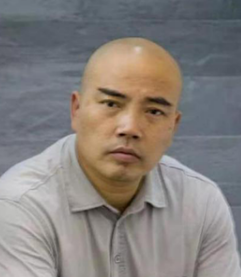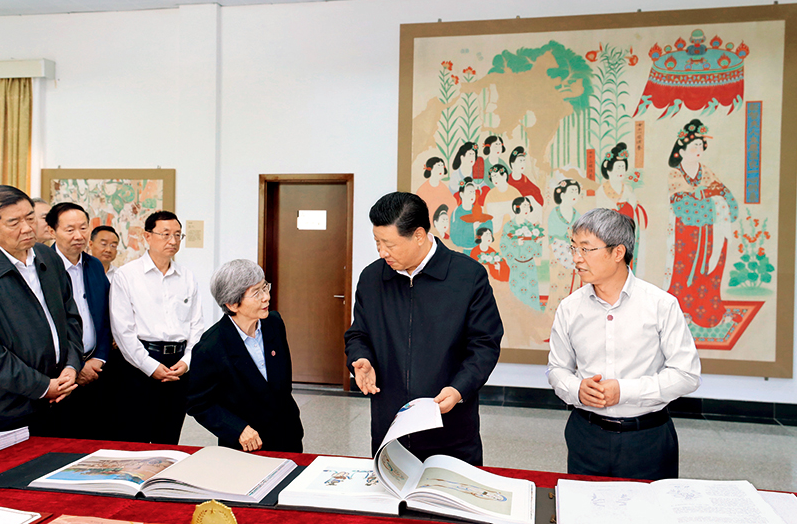"Dunhuang Impression" Chinese Porcelain Painting

Shang Hui
Director of the art theory Committee of China Artists Association
President, chief editor and doctoral director of fine arts magazine
As a witness of the civilization blending between China and Western Asia, Dunhuang has been attracting artists to worship since it was rediscovered in the early 20th century. From these clay sculptures and frescoes, they read about the art exchange between China and the West more than 1200 years ago, the earliest modern Oriental paintings in the desert sand dunes, and the realistic humanistic spirit revealed in the images and stories of gods. Although these stories are narrative, they all reflect the Oriental painting's highly refining of the real world through line drawing and color blocks. The reason why Dunhuang frescoes are still haunted and admired by today's artists lies in the fact that years have endowed these murals with a kind of damaged and primitive beauty formed in the natural weathering.
The fluidity of time creates damage and aesthetic charm which is easy to be lost and uncertain. This may be the source of the beauty of the porcelain paintings with the theme of "impression of Dunhuang" on display here. Although the porcelain painting drawn by high-temperature color glaze is a new type of painting popular in the world in recent years, the unique artistic charm of this glaze changing painting seems to have really obtained the liberation of artistic language when re painting Dunhuang murals. These porcelain painters have already got rid of the shackles of traditional handicraft porcelain painting, and focused on the changeable painting aesthetic creation endowed by glaze change. On the one hand, Dunhuang frescoes not only show the two-dimensional plane characteristics of drawing lines, but also do not completely equate with the elegant way in which the painting of inland literati weakens the color with the brush. Instead, the line does not hinder the color, and boldly strengthens the expression tension of color in the whole picture. On the other hand, Dunhuang murals, which still have the characteristics of central and Western Asia, have been formed under the erosion of a long history However, weathering, years give color line a variable and mysterious re creation. These two aspects have a natural coincidence with the artistic language of porcelain painting. "Dunhuang impression" porcelain paintings attract people is a kind of ingenious combination of line and color, and this kind of fit is formed naturally by burning fire, this kind of natural force. Here, the color glaze through the high temperature flow to destroy the integrity of the hook line, color glaze also through high temperature flame burning and obtain bright illusory rebirth.
Porcelain painting has changed since ancient times, but it has never been like today's artists to change the skill that should have been preset and controlled into a kind of painting language of glaze painting. What the painters pursue in these porcelain paintings is not to depict delicately and exquisitely, but to indulge these glaze color kiln changes naturally, and to express the uncertainty of glaze color flame as a mysterious force Self perception of the world and the expression of spiritual emotions. Those glaze paintings are no longer gorgeous and sweet, no longer completely new, no longer shiny, but deep silence, solemn, mysterious and illusory. Obviously, the high-temperature color glaze has formed a kind of aesthetic profundity which the porcelain painting lacks before. This is a kind of humanity spirit revelation from the auspicious folk culture aesthetic sublimation to the modern society, just like Pollock's abstract expressionism painting - only when liberated from the image description can line and color become a carrier and symbol of spiritual expression.
In fact, Dunhuang frescoes have the sacredness of depicting Buddhist deities, but what people open is not a Buddhist scripture which is far away from people's real life, but a kind of sacred natural force that nature constantly changes its original appearance. If the exhibition can not be separated from the new exploration of the language application of glaze color kiln transformation, then these paintings also show the new concept that glaze color kiln transformation, as a new type of painting, accords with the mystery of nature and the expression of subject spirit.
October 5, 2020 in Shanghai Green County Bookstore
PORCELAIN PAINTING

Minqi Fan
Experts with special allowance from the State Council
President of Jingdezhen Ceramic Art Research Institute
"Impression of Dunhuang" Chinese porcelain painting exhibition is "impression of Dunhuang". The Chinese porcelain painting works connect murals and ceramics, connect Dunhuang with Jingdezhen, Jiangxi Province, and connect the new language of color glaze porcelain painting with the interpretation of traditional classics. It reflects the unique charming of Chinese culture and art, and plays a boosting role in enhancing national cultural confidence, inheriting and developing traditional culture.
Dunhuang impression is the perfect integration of Dunhuang Art and ceramic culture. Its important mission is to transform the splendid Dunhuang mural art into "eternal" existence in a new way, so that the dream of Dunhuang murals is no longer a dream, and let the world understand the glorious Dunhuang mural, which is a splendid Chinese cultural treasure.

Lei Zi Ren
President of Jiangxi Painting Academy
Director of Jiangxi Art Museum
Because of the geographical and cultural differences between the northwest and the south of the Yangtze River, it is still obvious to this day that Dunhuang and Jingdezhen cannot be linked together without murals and ceramics.
The murals hidden in the sandstone of Mogao Grottoes, after thousands of years, are still dazzling. The belief painted on the clay wall conveys the emotional echo of lofty suffering. Jingdezhen ceramics, shaped in the mud fire, interprets the ordinary world into daily myths, and revolves the daily life of the people in the mud. The work based on the different concepts of the two places solidified their endless imagination of the universe, religion and life through the soil, and then became a historical picture, which contains the ever-growing upward aspirations of generations of craftsmen.
In this exhibition, practitioners try to use the new language of colored glaze and porcelain painting to re interpret the traditional classics, injecting new era concept and cultural connotation into the motif of history.
Agenda
Opening Ceremony: January 5, 2021
MC: Leader of Jiangxi Artists Association
09:00-09:30 Register
09:30-09:35 Pre-video
09:35-09:40 Speech by the leader of Jiangxi Federation of Literary and Art Circles
09:40-09:45 Speech by the leader of the International Olymp’Arts Committee
09:45-09:50 Speech by the leader of the International Joint Initiative Multilateral Cooperation Organization
09:50-09:55 Chinese Ceramic Art Master Fan Minqi delivers a speech
09:55-10:05 Speeches by representatives of the ambassadors of participating countries in China
10:05-10:10 Speech by representatives of participating artists
10:10-10:15 Leaders of Jiangxi Federation of literary and art circles announced the opening ceremony
10:15-11:00 Media interview/leadership visit
Contact Info:
Mr. Sun
13910538258
Building 12, Zhongguancun Internet Cultural Creative Industry Park, Linglong Road, Haidian District, Beijing










